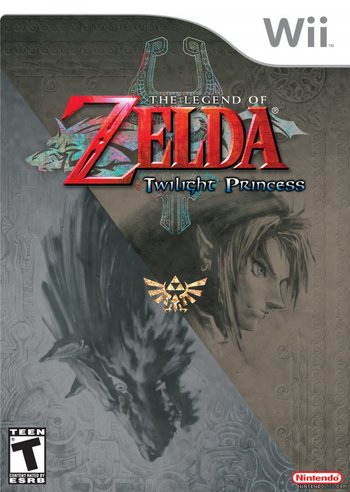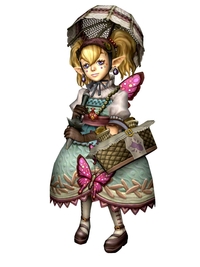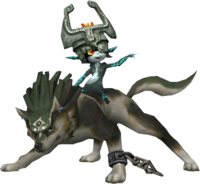
The Legend of Zelda: Twilight Princess
Platforms: GameCube, Wii
Release Date: November 19, 2006 (Wii version)
Publisher: Nintendo
Developer: Nintendo EAD
The announcement of The Legend of Zelda: Twilight Princess way back at E3 2004 was one of the most ridiculous game reveals of all time. Geeks everywhere basically lost their shit, screaming their lungs out and crying literal tears of joy.
While that level of emotional reaction may seem silly to some, there was good reason for it. There was something about that more realistic take on the beloved Zelda universe that fans absolutely fell in love with. The anger over Wind Waker’s art style largely subsided once people actually got their hands on it, but there was no denying that most were still aching for a return to the vision of Hyrule shown to us by the classic Ocarina of Time.
In that respect, Twilight Princess was a return to form and then some. It combined the realistic art style introduced by Ocarina with the darker tone of Majora’s Mask. By lifting Majora’s Mask’s shape shifting concept and altering it to suit its story, Twilight Princess also provided a hefty dose of something somewhat different from Zelda norm.
In fact, Twilight Princess differs quite a bit from the expected Zelda progression. From the very beginning of the game, things don’t quite play out as you might expect them to. The opening is actually rather slow, but deliberately so. It takes time to carefully build its story and introduce important characters, concepts, and themes. It’s a bit of a slow burn, but it feels more epic and exciting when things finally do get going as a result and lays the groundwork for a truly fantastic story.
After the opening, things continue down this slightly unusual path. The addition of Link’s wolf form and the necessity of clearing out the dangerous Twilight that has taken over Hyrule gives the game an opportunity to explore new gameplay avenues and change things up. There are, of course, no shortage of more traditional dungeons, but even these are improved on what we’ve seen before.
Twilight Princess continues Wind Waker’s movement toward unique dungeon environments different from what we’re used to from Zelda and it comes up with some fantastic locations. Even greater, it does a better job of leading the player from one dungeon to the next than prior games. It does this using its compelling story, actually giving the player a legitimate reason to visit most dungeons while minimizing the shiny object collection grind. The end result is a story that drives the player’s motivations the whole way through rather than devolving into a series of elaborate fetch quests with little plot progression like most Zelda games.
And the story truly is worthy of mention. Other Zelda games have certainly featured praise-worthy story elements, such as Wind Waker’s charming writing or Majora’s Mask’s touching moments, but Twilight Princess’s tale transcends what is expected of a Zelda game and becomes one of my favorite gaming stories of all time.
 A lot of this is due to a terrific cast of characters who are fleshed out more than you’d expect from the series. The sweet Ilia that hails from your hometown is a believable, and subtle, early love interest. The mysterious and troubled Princess Zelda is given a much larger role in the proceedings than normal, and even a compelling backstory. The children of Ordon Village appear numerous times, each with their own personality and charming dialog. “Princess” Agitha lives in Hyrule Castle Town collecting bugs while managing to be easily as creepy as she is cute. I could go on, but you get the point. Twilight Princess is swimming in memorable characters.
A lot of this is due to a terrific cast of characters who are fleshed out more than you’d expect from the series. The sweet Ilia that hails from your hometown is a believable, and subtle, early love interest. The mysterious and troubled Princess Zelda is given a much larger role in the proceedings than normal, and even a compelling backstory. The children of Ordon Village appear numerous times, each with their own personality and charming dialog. “Princess” Agitha lives in Hyrule Castle Town collecting bugs while managing to be easily as creepy as she is cute. I could go on, but you get the point. Twilight Princess is swimming in memorable characters.
Your little companion Midna is worthy of special mention. The way she is presented and written makes her by far my favorite character I’ve ever encountered in a Zelda game and, no hyperbole, up there with my favorite game characters of all time as well.
Her somewhat sarcastic and playful tone at the beginning of the game quickly makes her likable, but the sheer amount of screen time she is given thanks to her role in the story allows for a proper character arc, something Zelda previously hadn’t had much experience with. You’ll see how she changes as story events affect her personality and you’ll grow more attached to her as she does to Link. By pairing the silent protagonist of the series with a fairly constant companion, and one that does more than shout “Hey! Listen!” every five seconds, Twilight Princess gives itself room for character development like no other game in the series.
Other details also help sell her character. If ever there was a case to be made for voice acting in a Zelda game, Midna would be it. Though she didn’t speak in any recognizable language, her alien vocalizations lent a charm and depth to the character that no one else in a Zelda game has managed.
 Midna’s adorable little giggles coming through the Wii remote’s tinny speaker were another small touch that is still one of my favorite uses of that underutilized aspect of the Wii’s abilities. It extended her charming personality, however slightly, into the real world and made her feel more believable somehow.
Midna’s adorable little giggles coming through the Wii remote’s tinny speaker were another small touch that is still one of my favorite uses of that underutilized aspect of the Wii’s abilities. It extended her charming personality, however slightly, into the real world and made her feel more believable somehow.
But beyond the memorable characters, greater story presence, and improved plot progression throughout the game, what really sells the storyline for me is the brilliant ending. Nintendo dared to do something different here and gave the game a remarkably touching bittersweet conclusion that is not at all what I was expecting. It was one hell of a payoff. It’s one of the most touching finales I can remember playing and has stuck with me ever since.
Twilight Princess got knocked a little critically for being stagnant. I can see how one might say that when looking at the core mechanics and some outdated presentation elements, but ignoring the truly significant things that this game does brilliantly, and does differently than the rest of the Zelda series, is to overlook the best game the franchise has ever seen. It isn’t lightly that I admit I hold its story dear. It isn’t hyperbole when I praise its characterization. It isn’t thoughtlessly that I say its dungeons are memorable and its gameplay remains enthralling despite the lack of the revolution some were hoping for.
Maybe Zelda does need a kick in the pants. Maybe something different would do it some good. But personally, I’m glad the overhaul didn’t come earlier, because that would have deprived me of one of my favorite games of all time. The Legend of Zelda: Twilight Princess is a game I’m proud to call one of my Best of the Decade.